Related publications

Remote sensing determination of evapotranspiration: algorithms, strengths, weaknesses, uncertainty and best fit-for-purpose
23/10/2023
The publication aims to update the knowledge and enhance the capacity of water professionals, raise awareness of the strengths and limitations of remote sensing models and databases for evapotranspiration, and clarify operational aspects such as spatial and temporal resolutions and accuracy. Ultimately, it serves as a valuable reference for water actors and professionals working towards sustainable water resource management.
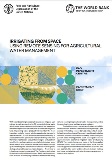
Irrigating from space: using remote sensing for agricultural water management
22/03/2023
This brief was produced by the FAO Investment Center under the FAO-World Bank Cooperative Programme and proposes concrete applications of WaPOR data in irrigation management by exploring the case of the Bekaa Valley.

The State of the World’s Land and Water Resources for Food and Agriculture 2021: systems at a breaking point
13/12/2021
SOLAW is a FAO flagship publication that analyses a variety of options for overcoming constraints and improving resource management in systems at risk: a mix of changes in institutional and policy measures will have to be combined with greater access to technologies.

Guidance on realizing real water savings with crop water productivity interventions
05/03/2021
This technical document contains clear and practical guidelines on how to implement real water savings in agriculture through interventions for enhancing crop water productivity. A distinction is made between real water savings and “apparent” water savings.

Water accounting & auditing guidelines
09/10/2020
FAO, together with other organizations, recommends water accounting and auditing as being fundamental to initiatives that aim to cope with water scarcity. This sourcebook wants to provide advice on the application and use of water accounting and auditing, helping users planning and implementing processes that best fit their needs.

Water Accounting and Auditing: A Sourcebook
01/01/2016
FAO, together with other organizations, recommends water accounting and auditing as being fundamental to initiatives that aim to cope with water scarcity. This sourcebook wants to provide advice on the application and use of water accounting and auditing, helping users planning and implementing processes that best fit their needs. Also available in french.

Yield gap analysis of field crops. Methods and case studies
01/01/2015
The publication reviews methods for yield gap analysis, clarifying definitions and techniques to measure and model actual, attainable and potential yield at different scales in space and time and using case studies to illustrate different approaches.
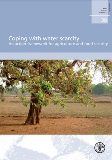
Coping with water scarcity: an action framework for agriculture and food security
01/01/2012
This report presents the conceptual framework, reviews a series of policy and technical options, and establishes a set of principles that should serve as a basis for the development of effective food security policies in response to growing water scarcity. Also available in French and Arabic.
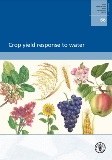
Crop Yield Response to Water
01/01/2012
This paper presents a set of tools packaged by FAO to better appraise and enhance crop yield response to water. These tools provide the means to sharpen assessment and management capacities required to: compare the result of several water allocations plans: improve soil-moisture control-practices under rainfed conditions; optimize irrigation scheduling (either full, deficit or supplementary); sustainably intensify crop production; close the yield and water-productivity gaps; etc.
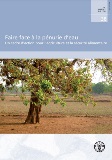
Coping with water scarcity. An action framework for agriculture and food security.
01/01/2012
This report presents the conceptual framework, reviews a series of policy and technical options, and establishes a set of principles that should serve as a basis for the development of effective food security policies in response to growing water scarcity. Also available in English and Arabic.

The State of the World’s Land and Water Resources for Food and Agriculture 2011: managing systems at risk
01/01/2011
The report analyses a variety of options for overcoming constraints and improving resource management in systems at risk. In each location, a mix of changes in institutional and policy measures will have to be combined with greater access to technologies for better management of land and water resources. Also available in French, Arabic and Spanish.
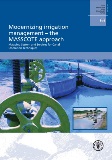
Modernizing irrigation management - the MASSCOTE approach
01/01/2007
MASSCOTE is a step-wise procedure for auditing performance of irrigation management, analyzing and evaluating the different elements of an irrigation system in order to develop a modernization plan. The aim is to work together with users in determining improved processes for cost-effective service-oriented management.
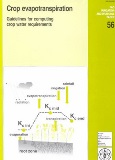
Crop evapotranspiration: guidelines for computing crop water requirements
01/01/1998
This publication presents a procedure for calculating reference and crop evapotranspiration from meteorological data and crop coefficients. The procedure, first presented in FAO Irrigation and Drainage Paper No. 24, Crop water requirements in 1977, allows estimation of the amount of water used by a crop, taking into account the effect of the climate and the crop characteristics.
